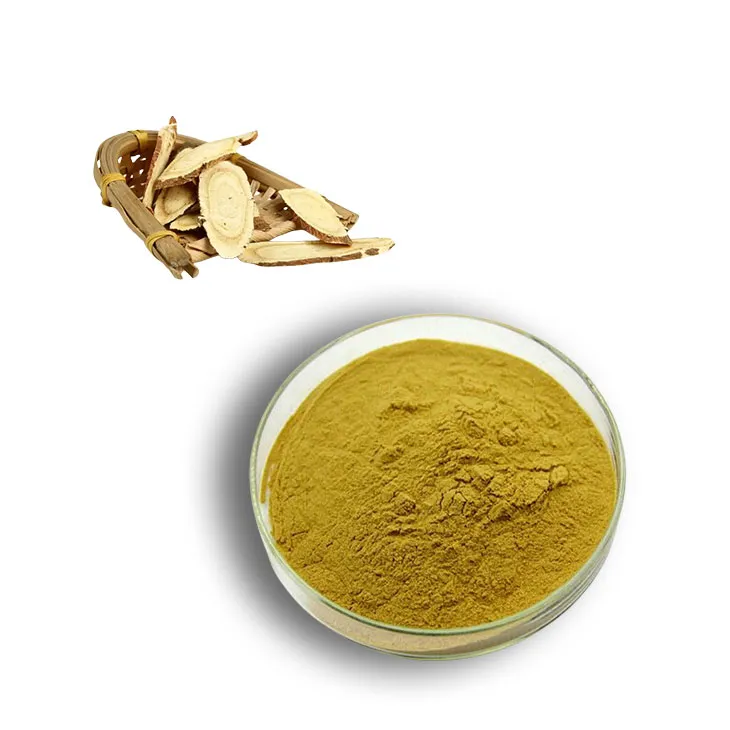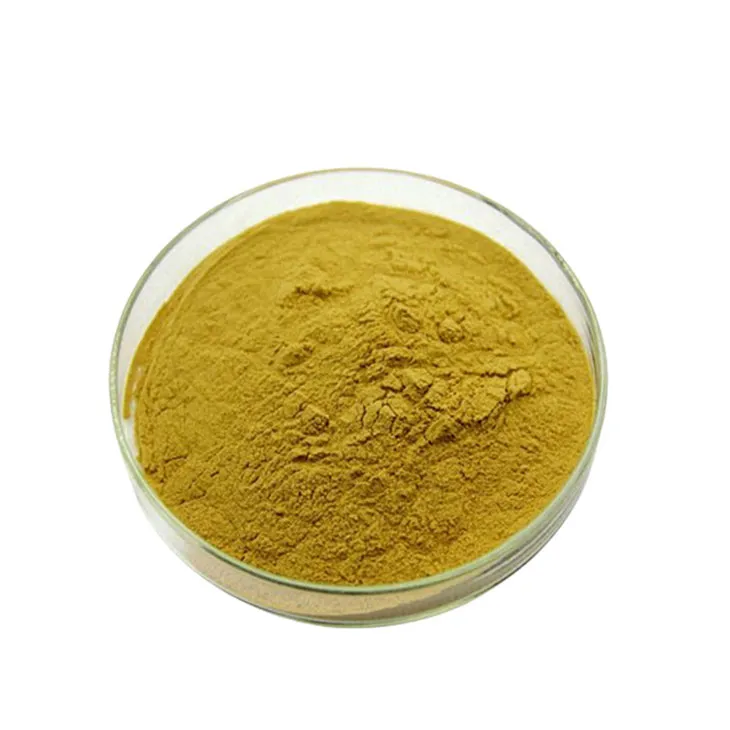- 0086-571-85302990
- sales@greenskybio.com
How to make powder with licorice root extract powder.
2024-12-01

1. Introduction
Licorice Root Extract Powder has a wide range of potential applications in various industries, such as the food, pharmaceutical, and cosmetic industries. Making powder from Licorice Root Extract Powder involves several crucial steps, from proper preparation of the initial extract to the final powder form. This article will provide a comprehensive guide on the process, along with quality control measures and potential applications of the resulting powder.

2. Initial Preparation of Licorice Root Extract
2.1 Source of Licorice Root
The first step in obtaining licorice root extract is to ensure a high - quality source of licorice root. Licorice can be sourced from different regions, and the quality may vary depending on factors such as soil conditions, climate, and harvesting methods. It is important to select licorice roots that are free from contaminants, such as pesticides, heavy metals, and microbial infections.
2.2 Extraction Methods
There are several methods for extracting the active compounds from licorice root:- Solvent Extraction: This is a common method. Organic solvents like ethanol or methanol can be used to dissolve the active compounds in the licorice root. For example, a certain proportion of licorice root powder can be mixed with ethanol in a sealed container and stirred at a specific temperature for a defined period. The solvent then contains the dissolved active ingredients.
- Hot - Water Extraction: Boiling water can also be used to extract the beneficial components from licorice root. The licorice root is soaked in hot water for a period of time, allowing the water - soluble compounds to dissolve. This method is more suitable for obtaining water - soluble active substances such as glycyrrhizic acid.
2.3 Filtration and Concentration
After extraction, the resulting solution needs to be filtered to remove any solid residues, such as plant fibers. Filtration can be achieved using filter papers or membrane filters. Once filtered, the extract solution is often too dilute for direct use in powder making. Therefore, concentration is required. This can be done through methods like evaporation under reduced pressure. By reducing the volume of the solution, the concentration of the active ingredients in the extract is increased.
3. Drying the Licorice Root Extract
3.1 Selection of Drying Method
Drying is a critical step in the process of making powder from licorice root extract. There are different drying methods available:- Air Drying: This is a simple and cost - effective method. The licorice root extract is spread out in a well - ventilated area and allowed to dry naturally. However, this method may take a relatively long time and is more suitable for small - scale production.
- Oven Drying: Using an oven set at a specific temperature (usually between 40 - 60°C) can speed up the drying process. This method provides more control over the drying conditions, but care must be taken not to overheat the extract, which may cause degradation of the active compounds.
- Freeze Drying: This is a more advanced method. The licorice root extract is frozen first and then the water is removed by sublimation under vacuum. Freeze - drying can better preserve the structure and activity of the active ingredients, but it requires more expensive equipment.
3.2 Monitoring the Drying Process
During the drying process, it is important to monitor the moisture content of the licorice root extract. This can be done using moisture analyzers or by simple weight - loss measurements. The goal is to reduce the moisture content to a very low level (usually less than 5%) to ensure the stability of the final powder product.
4. Grinding the Dried Licorice Root Extract
4.1 Choice of Grinding Equipment
Once the licorice root extract is dried, it needs to be ground into a fine powder. There are various types of grinding equipment available:- Mortar and Pestle: This is a traditional and simple grinding tool, suitable for small - scale production or laboratory use. It can be used to manually grind the dried extract into a powder, but it requires more labor and may not achieve a very fine and uniform powder.
- Electric Grinders: There are different types of electric grinders, such as blade grinders and burr grinders. Blade grinders are more common and can quickly grind the dried extract into powder. However, they may generate more heat during grinding, which may affect the quality of the powder. Burr grinders, on the other hand, can produce a more uniform and fine powder with less heat generation.
4.2 Grinding Parameters
When grinding, certain parameters need to be considered:- Grinding Speed: The speed of the grinder should be adjusted according to the nature of the dried extract. If the speed is too high, it may cause over - grinding and generate excessive heat.
- Grinding Time: The grinding time should be sufficient to obtain a fine powder but not too long to avoid quality degradation. For example, for an electric burr grinder, a grinding time of 5 - 10 minutes may be appropriate depending on the amount of the dried extract.

5. Sieving the Ground Powder
5.1 Purpose of Sieving
Sieving the ground Licorice Root Extract Powder is an important step to ensure the uniformity of the powder. Larger particles are separated from the fine powder, which improves the quality and consistency of the final product.
5.2 Sieving Equipment and Mesh Size
There are different types of sieving equipment available, such as manual sieves and vibrating sieves. The mesh size of the sieve also needs to be selected according to the desired fineness of the powder. For example, a mesh size of 80 - 100 mesh may be suitable for most applications, but for more refined products, a higher mesh size (such as 120 - 200 mesh) may be required.6. Quality Control Measures during Powder Production
6.1 Purity Analysis
Analyzing the purity of the licorice root extract powder is essential. This can be done through techniques such as high - performance liquid chromatography (HPLC) to determine the content of the main active ingredients, such as glycyrrhizic acid. Any impurities or contaminants should be within the acceptable limits.
6.2 Microbiological Testing
Microbiological testing should be carried out to ensure that the powder is free from harmful microorganisms, such as bacteria, fungi, and viruses. This can be achieved through methods like agar plate culture and polymerase chain reaction (PCR) testing for specific pathogens.
6.3 Particle Size Distribution Analysis
Measuring the particle size distribution of the powder is important for ensuring its quality and performance. Techniques like laser diffraction can be used to determine the range of particle sizes in the powder. A narrow particle size distribution indicates a more uniform powder, which is often preferred in various applications.7. Potential Applications of the Resulting Powder
7.1 In the Food Industry
Licorice root extract powder can be used as a natural sweetener, flavor enhancer, or preservative in the food industry. For example, it can be added to confectionery products to provide a unique flavor and sweetness, or used in meat products to extend their shelf life.
7.2 In the Pharmaceutical Industry
In the pharmaceutical industry, the powder may have anti - inflammatory, antiviral, and anti - ulcer properties. It can be used in the formulation of drugs for treating various diseases, such as respiratory infections, digestive disorders, and skin diseases.
7.3 In the Cosmetic Industry
Licorice root extract powder can be used in cosmetics for its skin - whitening, anti - aging, and anti - inflammatory effects. It can be added to creams, lotions, and serums to improve skin health and appearance.FAQ:
Q1: What are the necessary equipment for making powder with licorice root extract powder?
For making powder from licorice root extract powder, you may need equipment such as a grinder, a sieve, a mixing container. A grinder is essential for reducing the size of the particles. A sieve is used to ensure the uniformity of the powder by removing larger particles. And a mixing container helps in the proper blending of the powder if any additives are involved.
Q2: How should the licorice root extract powder be prepared before making it into a finer powder?
Before further grinding, it is important to ensure that the licorice root extract powder is dry. If there is any moisture, it can lead to clumping during the grinding process. You may also need to check for any impurities and remove them. This can be done by visual inspection or by using a simple sieving process at a larger mesh size initially.
Q3: What are the quality control measures during the powder - making process?
During the powder - making process, one of the important quality control measures is to monitor the particle size. This can be done by regularly checking the powder through a sieve of a known mesh size. Another measure is to check for the purity of the powder. This can involve chemical analysis to ensure that there are no contaminants. Also, the moisture content should be kept within a certain limit, usually a very low level to prevent spoilage and ensure proper powder flow.
Q4: Can additives be added during the process of making powder with licorice root extract powder? If so, what are some common additives?
Yes, additives can be added. Some common additives could be fillers like starch or cellulose if the aim is to increase the volume of the powder. Anti - caking agents such as silicon dioxide may also be added to prevent the powder from clumping. However, when adding additives, it is important to ensure that they are food - grade or suitable for the intended application if it is not for food.
Q5: What are the potential applications of the powder made from licorice root extract powder?
The powder made from licorice root extract powder has several potential applications. In the pharmaceutical industry, it can be used in the formulation of drugs, perhaps as an ingredient in cough syrups or lozenges due to its soothing properties. In the cosmetics industry, it can be added to creams and lotions for its antioxidant and skin - soothing effects. It may also be used in the food industry as a flavoring agent or in herbal teas.
Related literature
- Studies on Licorice Root Extract: Properties and Applications"
- "The Production and Quality Control of Herbal Extract Powders"
- "Licorice Root Extract in Pharmaceutical and Cosmetic Formulations"
- ▶ Hesperidin
- ▶ citrus bioflavonoids
- ▶ plant extract
- ▶ lycopene
- ▶ Diosmin
- ▶ Grape seed extract
- ▶ Sea buckthorn Juice Powder
- ▶ Beetroot powder
- ▶ Hops Extract
- ▶ Artichoke Extract
- ▶ Reishi mushroom extract
- ▶ Astaxanthin
- ▶ Green Tea Extract
- ▶ Curcumin Extract
- ▶ Horse Chestnut Extract
- ▶ Other Problems
- ▶ Boswellia Serrata Extract
- ▶ Resveratrol Extract
- ▶ Marigold Extract
- ▶ Grape Leaf Extract
- ▶ blog3
- ▶ blog4
- ▶ blog5
-
The best lemon juice powder in nature.
2024-12-01
-
Organic Vitamin K2 Powder Suppliers
2024-12-01
-
Bulk purchase of L - tyrosine.
2024-12-01
-
Vitamin K2 Manufacturers
2024-12-01
-
100% Pure Natural Rutin.
2024-12-01
-
Chinese Citrus Bioflavonoid Suppliers.
2024-12-01
-
Resveratrol extract
2024-12-01
-
Astaxanthin
2024-12-01
-
Nutmeg Extract
2024-12-01
-
Milk Thistle Extract
2024-12-01
-
Mangosteen extract powder
2024-12-01
-
Giant Knotweed Extract
2024-12-01
-
Aguaje Extract
2024-12-01
-
Sugarcane Extract
2024-12-01
-
Diosmin
2024-12-01
-
Europen Bilberry Extract
2024-12-01





















